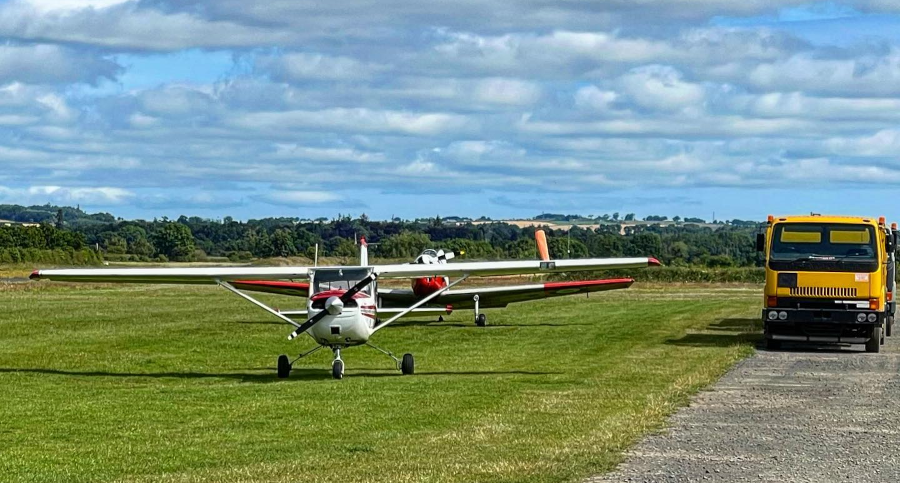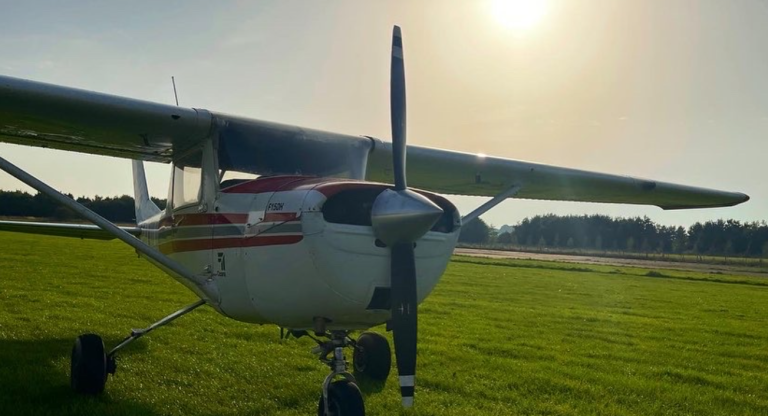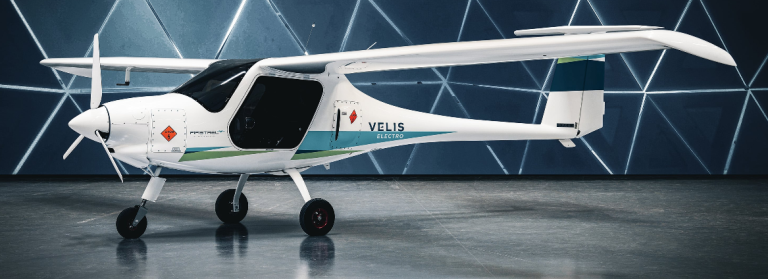Stalling 2. This was one of my most fun lessons yet. Building on the basic clean- and turning-stalls from last lesson today we would be simulating a bunch of close-to-the-ground stall situations that were a lot more dangerous – except we’d be doing them at 4,000ft (my new altitude record).
As with the previous lesson, I did the external and internal checks and started the engine before my instructor joined me in the cockpit.
I transmitted a radio message that I was going to be taxiing to holding point D and did just that. The pattern was empty and the wind was completely calm – the first time during my lessons that I wouldn’t have to compensate for wind. I took my time lining up before pushing the throttle forward.
Airborne
Once airborne I raised the nose to maintain Vy – best rate of climb. The air was silky smooth and I climbed out on runway heading (around 260 degrees) until 500ft, made a left climbing turn onto a heading of 170 degrees or thereabouts (we use a road for a visual reference in reality – the PPL is a visual flying license after all), and once at 1,000ft above airfield level (aal) I turned back over towards the airfield with the now-familiar radio call, “Uniform Juliet leaving the circuit to the north east, changing frequency to Scottish Information 119.875.” Learning to fly is all about repetition and building up muscle memory – nobody is born with ‘stick and rudder’ skills, it’s quite unnatural and you have to learn it.
I changed frequency to Scottish Information. “Request a basic service when you’re ready,” my instructor said.
Although he is very good at providing cheat sheets I wanted to test my mental recall and tried it without any crutches.
Basic (Service) B*tch
“Scottish Information, Golf-Alpha-Whisky-Uniform-Juliet, request basic service.”
“Uniform Juliet, pass your details,” came the reply, a request for more information about who we were.
I ran through my mental list.
- Who: “Uniform Juliet…”
- What (type of aircraft): “Cessna 150…”
- Persons on board: “2 POB…”
- Points of departure and arrival: “Eshott to Eshott…”
- Where: “South of Alnwick…”
- Route / intentions: “Routing Bamburgh castle and general handling…”
- Flight Rules: “VFR…” [visual flight rules]
- Request: “request basic service.”
Of course, I’d left out something vitally important.
“Where” in aircraft terms has two parts: geographical location, and vertical location.
“Altitude,” hinted my instructor, but the friendly gent on Scottish Information was on the ball.
“Uniform Juliet say altitude,” he said, Scottishly.
I read off the altimeter, “Two thousand niner hundred, QNH 1026.”
“Uniform Juliet roger, basic service, squawk 7401 and report Bamburgh Castle.”
“7401, report Bamburgh Castle, Uniform Juliet,” I said.
Frequency 119.875 is both Scottish Control and Scottish Information, providing a Flight Information Service (FIS) to VFR aircraft outside of controlled airspace (like us), and Air Traffic Control (ATC) service to aircraft under Instrument Flight Rule or within controlled airspace. How you refer to them (as Control or Information) depends on the type of service you need.
Thou Shalt Obey CAP413
My instructor is friendly and highly competent and a good laugh, but he takes his job very seriously – particularly the attention to detail, and especially when it comes to “R/T” – radio telephony. And I’d asked him to nit-pick if I got anything wrong before it became a bad habit.
“You don’t need to read back the report location bit, just say Wilco,” he advised. “It minimises transmit time.”
Now I know that this is precisely correct and it’s what I’ll do in future. He had confessed to reading the UK Civil Aviation Authority’s “Publication 413”, the Radiotelephony Manual. This is a comprehensive guide to radio usage within the UK’s airspace and it’s available as a free PDF to anyone, so if you’re interested, here’s the link.
Later on he would pick me up on another habit I’ve gotten into.
On first contact with a new air traffic controller or a new frequency, it’s customary (per CAP 413) to follow this syntax:
- Their name (e.g. “Heathrow Tower”)
- Your name (e.g. “KLM 123 Heavy”)
- Your request
and on subsequent radio calls you just use:
- Your name
- Your request
However, I had got into the habit of always saying the other station’s name on each radio call. As usual, I don’t know why, just a quirky bit of muscle memory.
Final Approach Stalls
Today we’d practice 3 more types of stalling:
- Final approach stalls
- Base to final stalls (which is a major killer of pilots)
- Go around stalls (which is also a big killer)
Final approach stalls happen when you’re too slow on approach to landing. Once you’re away from the ground, flying is quite – dare I say it – “easy”, or perhaps I should say less technical and less taxing, but when you’re close to the ground your role as a pilot is all about energy management.
The worst situation is to be “low and slow”. Slow speed by itself is not unsafe, as long as you have either a powerful enough engine to regain the speed quickly, or altitude that you can trade for speed by pitching the nose more down. Being low and slow is a recipe for danger, and being low and stalling is potentially life-threatening.
Just to be clear – the little Cessna does not have a powerful engine!
So I configured for landing with some changes to induce the stall: 20 degrees of flaps, but instead of 1700rpm I reduced power to 1500rpm, and maintained a half-and-half view out the front window (half ground, half sky). My speed slowly bled away until the air speed indicator (ASI) showed less than 40 knots and the stall warning horn squeaked.
For the stalls today we would be recovering at the first sign of the stall because these would be situations where a developed stall would effectively be fatal. The stall warning horn is usually the first sign of stall that we recover at, although good pilots should be able to recognise other signs of impending stall:
- Engine sounding different (i.e. quieter if power setting is less than intended/expected or indicating icing in the carb)
- Unusual attitude (e.g. high nose up attitude)
- Low speed (either indicated on the ASI or visually)
I immediately ran the recovery drill – left hand (pitch down), right hand (full power, carb heat cold), left hand (climb out, when at climb speed).
When you’re close to the ground pitching the nose forward is hellishly unnatural and counter-intuitive but it’s the only way to avoid the stall. This might mean you land heavy on your nose wheel or you damage the tips of your propeller on the runway, but these are all better outcomes than entering a spin and falling, uncontrollably, out of the air. Low altitude spins are usually fatal.
The trouble with having 20 degrees of flaps during stall recovery is that it’s really draggy so it takes aaaaaages to accelerate. As you can see on the track in the above video, there are long periods of straight and level flight – those are mostly waiting for the speed to come back up after a stall recovery with those big flap panels hanging out!
Once the stall has been avoided and speed is back up to 65 knots (Vy climb speed), we can pitch up and start regaining altitude. At 100ft above our simulated ground, we can retract one notch of flaps to 10degrees, and at 300ft we can raise flaps entirely, giving us full climb performance.
We did a few of these, building muscle memory that if the stall horn squeaks, you don’t think, you push that control column forward!
Next was practicing a very dangerous situation: base to final stalls.
Base to Final Stalls

These usually happen where the runway has a crosswind so that the wind comes from behind the aircraft on base leg. This has the effect of increasing the ground speed of the aircraft and pilots can reach the extended centreline faster than they expect.
One reaction pilots have to this is to bank the aircraft sharply and pull back on the control column to line up with the runway rather than ‘over shoot’ the centre line, and this is where stalls happen.
I configured the aircraft as if on base leg, 20 degrees of flaps, 1700rpm, half-sky and half-ground out the front window. Next, I banked as if turning final, using the attitude indicator (artificial horizon) to ensure I didn’t go beyond a 30degree bank, and I pulled back on the controls as if trying to reduce the radius of the turn. I was surprised at how quickly the airspeed dropped – the stall warning horn squeaked and my left arm sprang forward to release the back pressure on the controls while my right hand pushed the throttle to the fully open position, my thumb closing the carb heat while my hand held the throttle in place to prevent any unexpected rollback. And then I rolled wings-level.
As before, once we were at 65 knots, I started to climb and raised the flaps at the simulated 300ft altitude.
We did a few more of these (which I thoroughly enjoyed as it is a technical situation and this technique could save my life one day).
Go Around Stalls
These stalls are fairly common amongst student pilots, who may encounter a situation on approach which they don’t expect (e.g. an aircraft rolling onto the runway in error or failing to leave the runway by the time they get there), panic, and perform a go-around in that panicked state causing them to pull up too hard on the controls.
It’s worth noting at this point that I’d never done a go-around before (where the aircraft aborts the approach before landing), although I had done a few touch-and-goes.
I configured for final (still at 4,000ft), 20 degrees of flap, 65 knots, half-sky half ground attitude, 1700rpm. And I ran a new mnemonic to be run on approach, TRAP:
- T – Toes – clear of the toe brakes (see last lesson!)
- R – Runway – is it clear? In good condition? Is it the active runway? Is it long enough? Is there any wildlife nearby likely to enter the runway (a lot of private airfields are rural and this is a real risk!)
- A – Attitude – are you on profile, not too high or low? Is your airspeed right? Are you flying down the extended centreline?
- P – Permission – at controlled airports you need clearance to land. Without this clearance you can’t land (outside emergency situations).
I ran the TRAP memory items with my flight instructor (FI) playing the part of the air traffic controller on the intercom.
Me: “Toes clear, runway clear, on profile, Uniform Juliet final runway 26.”
FI: “Uniform Juliet, go around, I say again, go around.”
I followed the PAT process for climbing – power to full, carb heat closed, pulled back to Vy attitude and climbed out of the simulated approach.
FI: “And now panic!”
I pulled back on the controls and watched the ground fall out of the windscreen so I could only see sky. This may sound like the other stalls but there is an important difference. The other stalls happen with low power, this stall happens with full power and carb heat cold, so there are added aerodynamic effects on the aircraft from the ‘propwash’ and torque from the engine trying to roll the aircraft.
Even at full power, with 20 degrees of flaps still out our airspeed dropped quickly and the stall warning horn triggered.
The recovery is simpler than the other stalls because you’ve already got the power in. I pushed forward with my left hand to reduce the angle of attack (AOA), and just to be sure I checked the carb heat was closed with my thumb, and that mixture was still fully-rich with the little finger, the speed quickly came back and I flew straight and level until the speed recovered to Vy before continuing the climb away from the runway we had aborted our approach from.
Join Straight In and Putting the Training into Practice
It didn’t feel like a whole hour in the air had passed but I’d been busy / having fun so I trusted my FI’s aviator watch when he said to start heading back to the airfield.
I approached the airfield at overhead join height (1,500ft QFE), saw that the winds were still calm and opted for runway 26, which we’d taken off from earlier. I side-stepped to the deadside of runway 26 and transmitted “Golf-Alpha-Whisky-Uniform-Juliet, deadside descending runway 26” and descended to pattern height before turning over the departure end of that runway.
Once on downwind, I avoided the mistake I made the previous day, “Uniform Juliet, downwind runway 26.”
On base, I configured for landing, trimmed out the pressure on the controls and by the time I turned onto final, enabled by still air, I was only making tiny adjustments to the attitude and throttle to maintain approach profile.
I ran the memory checklist. “Toes clear of brakes, runway is clear, attitude is good, permission is ours.” (Permission is ours because it’s an uncontrolled airfield so landing is at our discretion).
At 100 feet above the ground I was pretty sure this would be a decent landing and was preparing to finesse the wheels onto the ground and maintain centreline with the rudder pedals.
“Uniform Juliet, clearance cancelled, go around, I say again, go around.”
My instructor had just thrown me a curve ball over the intercom.
Time to try a go-around for real – without stalling this time!
I pushed the throttle forward and closed the carb heat, while applying pressure on the right rudder pedal to counteract the yawing moment that going to full power induces. As approach speed and Vy are the same I was able to pull back on the controls straight away and used pitch to maintain 65 knots as the propeller dragged us upwards into the air, converting kinetic energy into gravitational potential energy (also known as ‘altitude’).
I flew the pattern again and lined up for 26, “Uniform Juliet, final runway 26.”
I guided the Cessna to the ground, navigated the farm machinery that was still at the end of the runway, and softly slipped the wheels onto the runway, maintained centreline and lowered the nosewheel to the ground. I sighed, it had been a really good lesson with plenty of take-aways.
“Full power!” said my instructor.
I pushed the throttle in, pushed the right rudder, closed the carb heat, checked the airspeed, the Ts and Ps and that the engine RPM was stable and confirmed the mixture was still fully rich with my little finger before it was time to fly again. Up we went again.
One more take off, one more circuit, and one more soft landing and the lesson was over. I ran the after-landing checklist, taxiied to the grass apron, and shut the plane down.
Next two lessons would be Circuits – all the take offs and landings you can imagine, including landing and taking off on the grass runway, and then it would be time to solo!




